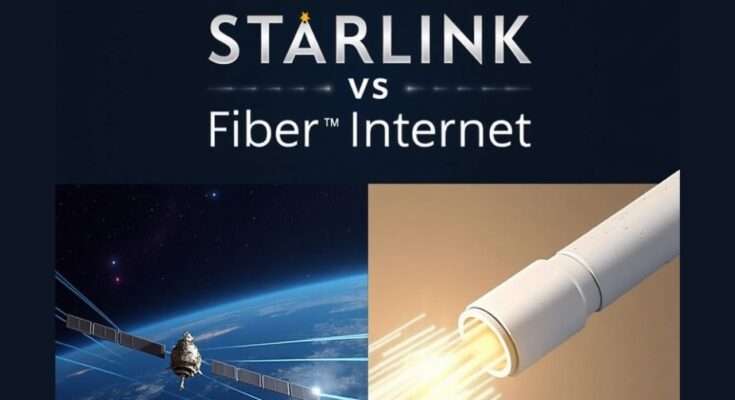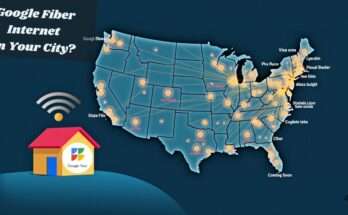In 2025, there’s a difference between Starlink, or any other provider aimed at diversifying internet connections (fiber, satellite, cellular, millimeter wave, etc.), and traditional fiber internet. SpaceX’s Starlink is a network of low Earth orbit satellites used to provide internet services, primarily in remote or disadvantaged areas. Unlike fiber internet, which is powered by high-speed optical cables, Starlink offers a different kind of performance with satellite connectivity, but fiber internet provides superior speed and lower latency. As technologies improve, the decision of which to choose will depend on location, required speed, and reliability. In this analysis, we look at the pros and cons of each option to help consumers determine which internet service is best suited for their needs.
Starlink vs Fiber– Overview
SpaceX’s Starlink is a satellite internet service designed to deliver high-speed connectivity in remote and underserved locations. This is a network of low Earth orbit satellites that, when there is no traditional infrastructure, provide internet. Comparing Satellite vs fiber internet looks at a difference in technology, as fiber optic internet transmits data through fiber cables, using light signals for faster, more reliable service with symmetrical (or the same) upload and download speeds.
Starlink connection is fairly unreliable and slow, usually with high latency, so fiber optic connections typically have lower latency and better performance. Your location, the internet needs, and the usage you need (like a potential gaming hot spot) will help you choose between Starlink and fiber.
Starlink vs Fiber Optic Plans and Pricing
| Service Provider | Plan Type | Download Speed | Upload Speed | Monthly Cost | Installation Fees |
|---|---|---|---|---|---|
| Starlink | Residential Plan | Up to 200 Mbps | Up to 20 Mbps | $110/month | $549 (equipment cost) |
| Fiber Optic | Basic Plan | Up to 300 Mbps | Up to 300 Mbps | $70/month | $0 – $100 (varies) |
| Fiber Optic | Pro Plan | Up to 1 Gbps | Up to 1 Gbps | $100/month | $0 – $100 (varies) |
| Fiber Optic | Premium Plan | Up to 2 Gbps | Up to 2 Gbps | $150/month | $0 – $100 (varies) |
Fiber vs Starlink: Speed Comparison
The most important cause when choosing an Internet service provider is speed. Below there is a differentiation of the speeds offered through Starlink and Fiber services.
- Starlink Internet provides 25 Mbps to 500 Mbps download speeds with an average user speed of 66 Mbps. Latency usually occurs in latencies from 20 ms to 50 ms depending on the weather situation.
- Fiber Optic Internet provides speeds from 100 Mbps to 2 Gbps (2000 Mbps) or up. This depends on the provider. Typically latency is provided between 1 ms to 10 ms later. A stable maximum connection for jobs such as video discussion or gaming this Internet plan.
Performance and Reliability
Fiber vs Starlink on performance is a huge disparity. Although fiber optic internet tends to be a bit more unreliable with more interruptions and less stable connection, by having high-speed internet, weather conditions do not affect the user’s service.
Starlink’s service has gotten better, but it still suffers from occasional snaps from factors like a big rain, snow, or some sort of obstruction in the sat signal. Is Starlink faster than fiber is a common question, and while Starlink is a great solution for those in rural areas, it might not be the best solution for people who need constant, high-speed connectivity for work or gaming.
Pros and Cons – Starlink Internet vs Fiber
Starlink Internet
Pros:
- Broad Coverage: Where remote or underserved areas cannot be reached.
- Improved Speeds: Download speeds: 50 to 250 Mbps.
- Mobility: It can be used in any location with a clear sky.
Cons:
- Higher Latency: This supports real-time applications with latency ranges from 20 to 40 ms.
- Weather Sensitivity: Adverse weather conditions may disrupt service.
- Cost Considerations: $549 for one-time equipment, $110 a month.
Fiber Optic Internet
Pros:
- Superior Speed and Reliability: Maxed out at speeds up to 10 Gbps with low latency (as low as 1 ms).
- Stable Connection: Dirt impact and weather are less of a factor.
- Symmetrical Speeds: It offers equal upload and download speed.
Cons:
- Limited Availability: More difficult to set up in rural areas, but much less so than Starlink.
- Higher Initial Costs for Installation: Installation fees can range up to $100, and the monthly costs is between $70 and $150.
Conclusion
Your needs will determine whether it is Starlink vs fiber optic internet. Starlink is likely your best bet if you’re in a rural area without traditional wired connections and need mobility. On the flip side, if you focus on speed, reliability, low latency and things like gaming or streaming, fiber optic internet is the right choice. Then you’ll be able to make an informed decision based on your own internet usage habits and location. Both options will only improve as technology advances, and the future of internet connectivity will be changed with it. To know more about high speed Internet plans, get in touch with Internet Cost Saver customer care number – +1(855) 208-9742.



